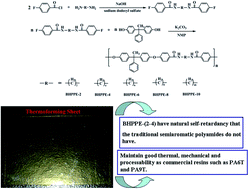Semiaromatic polyamides containing ether and different numbers of methylene (2–10) units: synthesis and properties†
Abstract
A series of semiaromatic difluorobenzamide monomers was synthesized by the reaction of diamine and 4-fluorobenzoic chloride using a facile interfacial method. These syntheses were conducted to react the monomers with 1,1-bis(4-hydroxyphenyl)-1-phenylethane (BHPPE), so as to prepare semiaromatic polyamides containing ether units by the method of nucleophilic polycondensation. These had excellent thermal properties with glass transition temperatures (Tg) of 134.4–195.6 °C and initial degradation temperatures (Td) of 405–443 °C. The activation energies of degradation were in the range of 180.1–275.9 kJ mol−1. The resultant polymers can be dissolved in strong polar solvents and supply a tough film with a tensile strength of 89–105 MPa. Also, we found that the complex viscosities of these semiaromatic polyamides ranged from 77 to 688 Pa s at 290 °C. They had the appropriate complex viscosities for melt processing. Moreover, they had much wider processing windows than those of traditional semiaromatic polyamides such as poly(hexamethylene terephthalamide) (PA6T). Interestingly, some of the resultant polymers were found to be naturally self-retardant.


 Please wait while we load your content...
Please wait while we load your content...